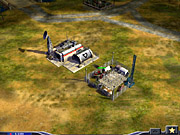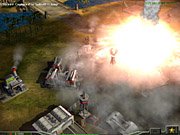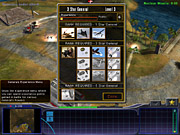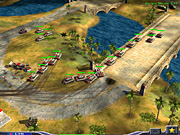Command & Conquer: Generals Updated Preview
We've got new impressions from the recently released multiplayer test for this highly anticipated real-time strategy game.
Electronic Arts' recent announcement that the highly anticipated next installment in the Command & Conquer universe, Generals, was going to be delayed yet again understandably sent a wave of disappointment through fans of this long-running series. Even though the game was announced less than a year ago, the developers at EA Pacific were confident that they would have the game on store shelves in time for the holiday rush, but that wasn't to be the case. As it did with SimCity 4 and the PlayStation 2 version of The Sims, Electronic Arts decided to hold off the release of Generals in order to prevent the cannibalization of its own products--as most gamers are quite aware of right now, there is an absolute flood of games on the market. Rather than compete with hundreds of other games, Generals will be released in February, after things have settled down a bit, so to speak. Since the game is essentially finished, this slight delay will also give the developers more time to polish Generals and, for the first time for any Command & Conquer game, time to implement changes from feedback that they'll receive from the recently launched multiplayer test. Though it's a common occurrence for many real-time strategy games, no other entry in the Command & Conquer franchise has gone through a typical external "beta test" or "multiplayer test," as these testing events are often called. Several GameSpot editors, alongside nearly 3,000 other testers from North America, South Korea, and Europe, have been playing this multiplayer build for a little over a week now, and we're impressed with some of the changes that Generals has implemented in the series. We previously noted what you should expect in the single-player component of the game, so let's take a look at some of the multiplayer-specific aspects of Command & Conquer: Generals.

Asides from the jump to an impressive 3D engine, Generals' inclusion of a peon class unit is the biggest change to the series. As you're undoubtedly aware of by now, the game features three distinct sides--the US, China, and the Global Liberation Army--each of which not only has a unique look and its own set of units, but plays completely differently from the others. This becomes immediately apparent during the first few seconds of any multiplayer match. Instead of having structures magically appear when you cue up their construction, Generals forces you to build using a peon unit, which, in the shape of harvesters, have been used in previous Command & Conquer games solely to collect resources. The peons for the three sides behave drastically differently from each other and, for the most part, are split into two unique groups: collectors and builders. The wheel loader, for example, is the US side's builder unit. To build any structure in the game, from the defensive Patriot batteries to the reflex ion cannon superweapon, you need to have a wheel loader assigned to that job. The Chinese, on the other hand, make use of a bulldozer to build all of their structures. This dozer, as well as the US wheel loader, can be assigned to repair damaged structures as well. It's interesting to note that most buildings in Generals will automatically repair themselves after they sustain a certain amount of damage, but micromanaging a peon builder to manually repair will increase that building's repair rate substantially. The GLA, which is supposed to represent the typical Hollywood and media representation of the common terrorist group, uses workers to build and repair all of its structures. Even though the peon units for all three sides vary in size and appearance, they can all perform their tasks in roughly the same amount of time.

Resource collection, at least for the US and the Chinese, is accomplished by a completely different unit. For the US side, this unit is the CH-47 Chinook tandem-rotor chopper. You'll automatically receive one of these helos once you construct your supply depot, but every subsequent one will cost you $1,200. The Chinook will automatically head to the nearest supply stash--the resource in Generals is a generic lump of crates--pick up $600 worth of supplies, and bring it back to the supply depot. These Chinooks travel fast and have the capability of transporting troops and tanks, but they're relatively slow at picking up and dropping off supplies. Additionally, losing a Chinook to enemy fire can be particularly devastating, especially if it happens early on in a given match. Conversely, the GLA's resource collector is the same unit as its builder: the worker. When built from the GLA's version of the supply depot, these workers will automatically walk over to the nearest stash and bring back $75 worth of supplies. Though they're slow and vulnerable and can't carry a lot, they're extremely cheap and fast to produce. Consequently, you'll cue up literally a handful of these workers at once, and the result looks more like an ant farm than a sophisticated supply line. And if you happen to lose a couple, who cares? Just make more. The mentality of the Chinese resource collectors lies somewhere between the two extremes of the US and the GLA. They use flatbed trucks that can carry considerably more than the GLA worker but about half the payload of the US Chinook. They also cost somewhere in the middle and have a movement and docking speed that are not as fast as a helicopter but not as slow as a worker. Regardless of which side you choose, proper management of the resource collectors for the US, China, or the GLA will yield significant results.
What Makes the World Go Round
Managing your income is obviously important, because RTS matches can be won or lost on production alone. The face of resource collection changes significantly as a match progresses. Each side has the ability to build a late-game structure or unit that will perpetually generate income. For example, the US side can construct a supply drop if it has a strategy center built. This is basically a landing pad that a C-130 will air-drop supplies to every two minutes. With numerous supply drops, you won't have to depend on your Chinook supply lines anymore. In fact, securing these persistent income generators is imperative, since stashes have only a finite supply of goods, and it doesn't take very long for all the resources in a given map to be depleted by overproductive players. The similar structure for the GLA is the black market, which generates around $20 every handful of seconds, and the Chinese have a hacker unit that will get $5 (and later on, $8) every few seconds. Building numerous hackers and multiple black markets will generate a sizable income and removes your dependency on the trucks and workers, respectively. There are even more ways of generating revenue in Generals. As in Red Alert 2, you can send troops to garrison neutral structures, and you can also use them to capture oil derricks. Once you seize one of these locations, you'll receive a one-time bonus of $1,000 and gain around $200 every 20 to 30 seconds.

To do so, you'll need to purchase a specific upgrade that will let you capture oil derricks, and after a few rounds with the game, you'll find that Generals makes significant use of unit and structure upgrades, a mechanic that's been successfully employed in previous RTS games like Starcraft, Age of Empires II, and Battle Realms. The game's three sides make very different use of their upgrades, and some have more than others. The US, for example, is able to equip its crusader tanks with a UAV drone (essentially an RQ-1 Predator) that increases that unit's field of vision by 50 percent. The US can also upgrade its tanks with a battle drone that can heal its host unit when it sustains damage and complement its main cannon with a chaingun that's particularly effective against ground troops. Other upgrades serve to balance the perceived disadvantages of like units. The Chinese MiG, for example, can get a 25 percent armor bonus, while its main rival, the US F-22 Raptor, can be upgraded with a bonus that increases its missile power by 25 percent.

It's interesting to note that the general system we've mentioned in earlier previews is nowhere to be found in the game now. The designers felt that the mechanic of choosing between one of three generals in order to get unique strategy or building bonuses was broken, and rather than try to put Band-Aid after Band-Aid on it, they removed it from Generals altogether. In its stead is an experience point system that lets you purchase new abilities as you progress through a match. Every side will have around eight different abilities that can be purchased as you, the general, go up in rank. Getting these promotions involves successfully attacking and defeating a certain number of the opposing side's units and structures. The more destruction you dole out, the higher your rank becomes, and the more purchase options you get. As an example, as the US side, you'll be able to call in an A-10 strike once you attain a three-star ranking, and depending on the number of points you've accrued, this strike can be composed of one, two, or three powerful A-10s, which you can use to target any visible unit or structure. Other purchase options include an EMP pulse for the Chinese and a fuel-air explosive for the US side.
It's certainly interesting to see Generals implement some design elements from other real-time strategy games while keeping a distinct Command & Conquer feel to the game. For example, you can build numerous war factories, barracks, and airstrips in order to increase your production of vehicles, soldiers, and airplanes, respectively. Among other things, this means that the much maligned tank rush is back, though there are numerous ways of offsetting this tactic, including the use of choke points, airpower, or mines, which are a particularly nasty calling card of the Chinese. It's also important to note that the figures, gameplay mechanics, and strategies mentioned here might be completely different tomorrow. The developers at EA Pacific are taking feedback from testers, both external and internal, and making necessary changes to countless factors in the game. As has been shown with Warcraft III, strategies that worked two months ago might not necessarily work today. Just this week, in fact, the test build was patched to improve the network code as well as other minor balance glitches. Generals will be ever-evolving between now and its final release date, and we'll bring you new details on these changes as they occur. Command & Conquer: Generals is slated for a February 11, 2003, release.
Got a news tip or want to contact us directly? Email news@gamespot.com
Join the conversation